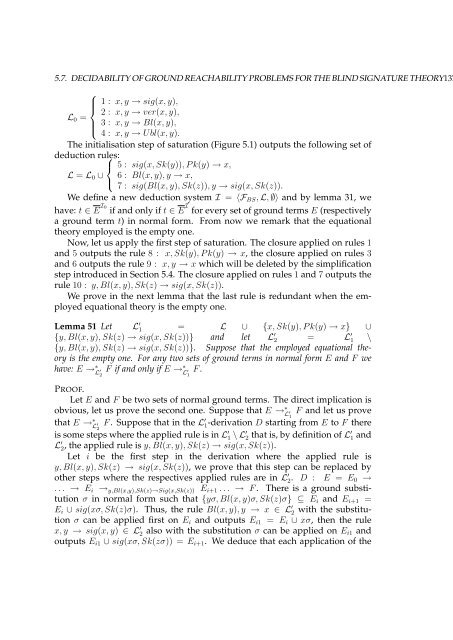Logical Analysis and Verification of Cryptographic Protocols - Loria
Logical Analysis and Verification of Cryptographic Protocols - Loria
Logical Analysis and Verification of Cryptographic Protocols - Loria
Create successful ePaper yourself
Turn your PDF publications into a flip-book with our unique Google optimized e-Paper software.
5.7. DECIDABILITY OF GROUND REACHABILITY PROBLEMS FOR THE BLIND SIGNATURE THEORY137<br />
⎧<br />
⎪⎨<br />
1 : x, y → sig(x, y),<br />
2 : x, y → ver(x, y),<br />
L0 =<br />
⎪⎩<br />
3 : x, y → Bl(x, y),<br />
4 : x, y → Ubl(x, y).<br />
The initialisation step <strong>of</strong> saturation (Figure 5.1) outputs the following set <strong>of</strong><br />
deduction rules: ⎧<br />
⎨ 5 : sig(x, Sk(y)), P k(y) → x,<br />
L = L0 ∪ 6 : Bl(x, y), y → x,<br />
⎩<br />
7 : sig(Bl(x, y), Sk(z)), y → sig(x, Sk(z)).<br />
We define a new deduction system I = 〈FBS, L, ∅〉 <strong>and</strong> by lemma 31, we<br />
have: t ∈ E I0<br />
if <strong>and</strong> only if t ∈ E I for every set <strong>of</strong> ground terms E (respectively<br />
a ground term t) in normal form. From now we remark that the equational<br />
theory employed is the empty one.<br />
Now, let us apply the first step <strong>of</strong> saturation. The closure applied on rules 1<br />
<strong>and</strong> 5 outputs the rule 8 : x, Sk(y), P k(y) → x, the closure applied on rules 3<br />
<strong>and</strong> 6 outputs the rule 9 : x, y → x which will be deleted by the simplification<br />
step introduced in Section 5.4. The closure applied on rules 1 <strong>and</strong> 7 outputs the<br />
rule 10 : y, Bl(x, y), Sk(z) → sig(x, Sk(z)).<br />
We prove in the next lemma that the last rule is redundant when the employed<br />
equational theory is the empty one.<br />
Lemma 51 Let L ′ 1 = L ∪ {x, Sk(y), P k(y) → x} ∪<br />
{y, Bl(x, y), Sk(z) → sig(x, Sk(z))} <strong>and</strong> let L ′ 2 = L ′ 1 \<br />
{y, Bl(x, y), Sk(z) → sig(x, Sk(z))}. Suppose that the employed equational the-<br />
ory is the empty one. For any two sets <strong>of</strong> ground terms in normal form E <strong>and</strong> F we<br />
F .<br />
have: E → ∗<br />
L ′ 2<br />
PROOF.<br />
F if <strong>and</strong> only if E → ∗<br />
L ′ 1<br />
Let E <strong>and</strong> F be two sets <strong>of</strong> normal ground terms. The direct implication is<br />
F <strong>and</strong> let us prove<br />
F . Suppose that in the L ′ 1-derivation D starting from E to F there<br />
obvious, let us prove the second one. Suppose that E → ∗<br />
L ′ 1<br />
that E → ∗<br />
L ′ 2<br />
is some steps where the applied rule is in L ′ 1 \ L ′ 2 that is, by definition <strong>of</strong> L ′ 1 <strong>and</strong><br />
L ′ 2, the applied rule is y, Bl(x, y), Sk(z) → sig(x, Sk(z)).<br />
Let i be the first step in the derivation where the applied rule is<br />
y, Bl(x, y), Sk(z) → sig(x, Sk(z)), we prove that this step can be replaced by<br />
other steps where the respectives applied rules are in L ′ 2. D : E = E0 →<br />
. . . → Ei →y,Bl(x,y),Sk(z)→Sig(x,Sk(z)) Ei+1 . . . → F . There is a ground substitution<br />
σ in normal form such that {yσ, Bl(x, y)σ, Sk(z)σ} ⊆ Ei <strong>and</strong> Ei+1 =<br />
Ei ∪ sig(xσ, Sk(z)σ). Thus, the rule Bl(x, y), y → x ∈ L ′ 2 with the substitution<br />
σ can be applied first on Ei <strong>and</strong> outputs Ei1 = Ei ∪ xσ, then the rule<br />
x, y → sig(x, y) ∈ L ′ 2 also with the substitution σ can be applied on Ei1 <strong>and</strong><br />
outputs Ei1 ∪ sig(xσ, Sk(zσ)) = Ei+1. We deduce that each application <strong>of</strong> the
















